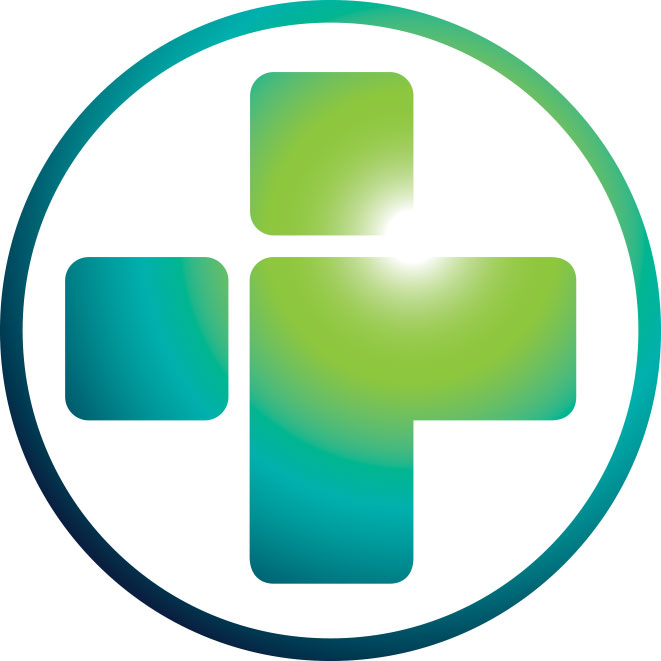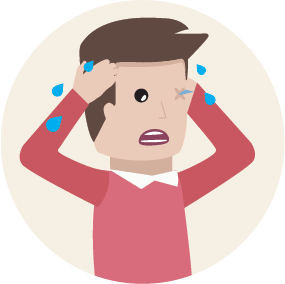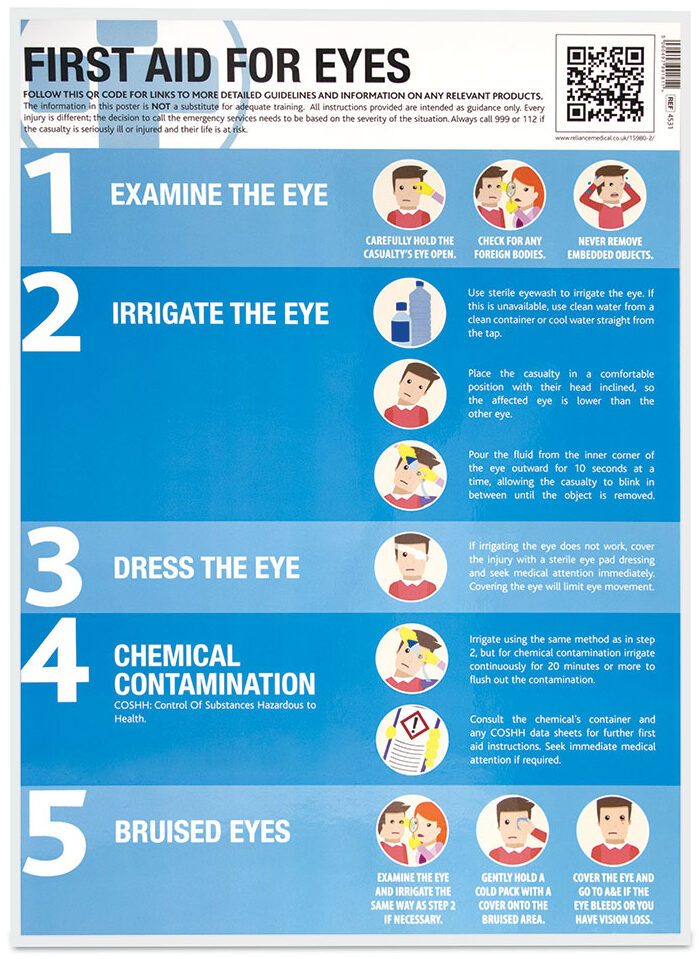First Aid for Eyes
Additional material to support your information poster, with a quiz to test your knowledge.
Types of Eye Injury
The eye is a delicate structure that is easily damaged, but many eye injuries are preventable if the appropriate safety precautions are taken. All eye injuries are potentially serious because they can damage a person’s vision. Even grazes to the surface of the eye, (the cornea), can lead to scarring or infection, which could permanently damage someone’s vision. Eye injuries can occur in many settings, including at home, at work, or when playing sports.
Common types of eye injury include:
Blows to the eye – such as being hit by a fist, elbow, or ball
Scratches and abrasions – caused by fingernails or tree branches etc.
Foreign bodies – such as small pieces of grit, wood, or metal getting in the eye
Penetrating or cutting injuries – such as cuts from glass or projectiles flung from tools, especially when hammering or using power tools
Chemical burns – such as exposure to household cleaning products
To combat these common injuries, always wear protective eye wear when working with any material that can cause damage to eyes.
MINOR EYE IRRITATIONS
Minor irritation or injury to the front of the eye does not usually require medical treatment and should normally clear up within 24 hours. To prevent further damage, don’t touch or rub your eye, or wear contact lenses until it’s fully healed. See your GP or Optician if you have any concerns about your injury, or if it’s not better within 24 hours.
MAJOR EYE IRRITATIONS: WHEN TO SEEK MEDICAL ATTENTION
Casualties should immediately be taken to the nearest Accident and Emergency if they have:
Persistent or severe eye pain
Foreign bodies that can’t be washed out
Decreased or double vision
Flashing lights, spots, halos, or shadows in their field of vision
Blood is visible in the eye
An irregularly shaped pupil
Every injury is different. The decision to go to A&E versus calling the Emergency Services needs to be based on the severity of the situation.
Always call 999 or 112 if the casualty is seriously ill or injured and their life is at risk.
First Aid for Eyes
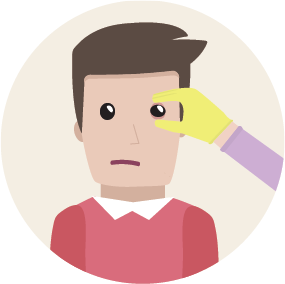

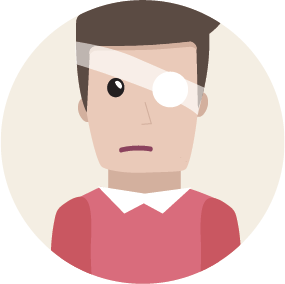
1. EXAMINE THE EYE
Firstly, ask the casualty if they know the source of the contamination. Hold the casualty’s eyelid open with your thumb and forefinger, then ask the casualty to look up, down, left, and right so that you can check for any foreign bodies on the eye’s surface. If you can see foreign bodies, irrigate the eye.
NEVER attempt to remove a foreign body that is embedded in the surface of the eye. This should only be done by an expert eye doctor.
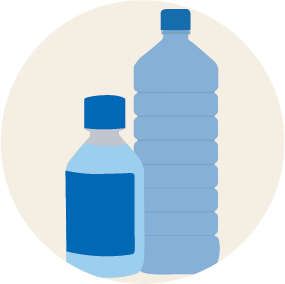

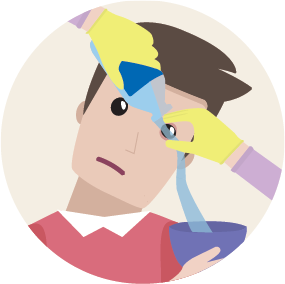
2. IRRIGATE THE EYE
Sit the casualty down in a comfortable and inclined position, with their head tilted so the affected eye is lower than the unaffected one.
Use sterile eye wash to irrigate the eye. If this is unavailable, use clean water from a clean container, or cool water straight from the tap. If using sterile eye wash, ensure that the bottle is sealed, in-date, and that the contents are clear before using them. If using tap water, ensure the temperature is cool, not warm, and only use a container that is completely clean.
Wash the eye out by pouring water from the inner corner of the eye outward for 10 seconds at a time, allowing the casualty to blink in-between.
Continue irrigating until the foreign body is removed.

3. DRESS THE EYE
If irrigating the eye does not work, cover the injury with a sterile eye pad dressing and seek medical attention immediately. If it will be a while before you can get medical help, use a bandage to hold the pad in place.
Advise the patient to keep the uninjured eye closed (if possible), to reduce risking movement of the injured eye.
N.B. If a large fragment of material is protruding from the eye, first immobilise it with rolled dressings on either side of the object rather than putting a dressing over the top, as this would cause further damage.
Take the casualty to your nearest Accident and Emergency Department (A&E) immediately.
Chemical Contamination of Eyes
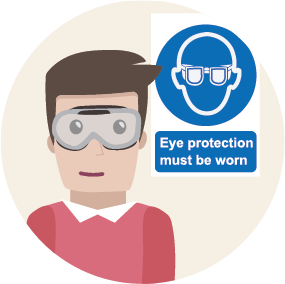

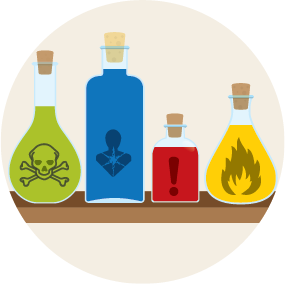
Prevention is better than cure!
Before using chemicals, workers should be fully trained and familiar with all Health and Safety COSHH legislation.
When tending to a casualty with chemical contamination injuries, protect yourself by wearing gloves.
Incline the casualty’s head and irrigate in the same way as with normal eye irrigation, but irrigate IMMEDIATELY and CONTINUOUSLY for 20 minutes or more to flush out the contamination.
Refer to the chemical’s container and any COSHH data sheets for further first aid instructions, (COSHH: Control Of Substances Hazardous to Health).
Cover the eye as directed above (3), and seek immediate medical attention.
Bruised Eyes


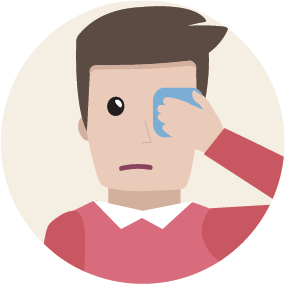
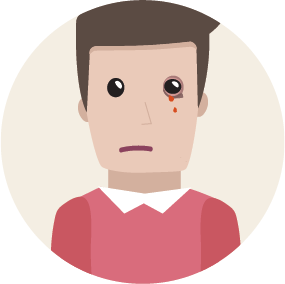
Examine the eye carefully by holding the casualty’s eyelid open with your thumb and forefinger, then ask the casualty to look up, down, left, and right so that you can check for any foreign bodies on the eye’s surface. If you can see foreign bodies, irrigate the eye.
After careful irrigation, and using gentle pressure, take a cold pack or a cloth filled with ice, and apply it to the area around the casualty’s eye. Take care not to press on the eye itself.
If the casualty experiences vision problems, or there are signs of bleeding in either the white or coloured parts of the eye, seek medical assistance immediately.
Information based on the NHS’ “Eye Injuries: What to do.”
First Aid For Eyes Quiz
A short quiz to test your knowledge of first aid for eyes.

All information is for guidance only and correct at time of publication.

